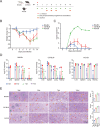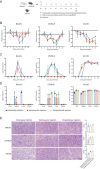The Biological Characteristics and Mouse Model of Lassa Virus From the First Imported Case in China
- PMID: 40761480
- PMCID: PMC12318830
- DOI: 10.1002/mco2.70315
The Biological Characteristics and Mouse Model of Lassa Virus From the First Imported Case in China
Abstract
Lassa fever (LF) is a fatal hemorrhagic disease caused by the Lassa virus (LASV), which mainly spreads in Africa. As China's interactions with Africa become more frequent, the risk of LF being imported into China also rises, making the study of LASV increasingly urgent. In this study, the Lineage IV LASV strain was successfully isolated from the first imported case in China. Compared with the LASV genome, the isolated strain may exhibit greater infectivity and interspecies transmission capabilities. We successfully established BALB/c, C57BL/6, and AG129 mouse infection models and found that intranasal inoculation was the most stable infection method. Select the anti-LASV drug LHF-535 for preliminary evaluation, further confirming the stability of the model. In summary, the isolated strain exhibits enhanced transmission capabilities and may spread between mice via the respiratory tract, meriting greater attention and emphasis. This study will bridge the gap in China's independent P4-level pathogen isolation, meet national biosafety and strategic needs, and provide certain support for LASV research.
Keywords: Lassa virus; biological characteristics; mouse infection model; virus isolation.
© 2025 The Author(s). MedComm published by Sichuan International Medical Exchange & Promotion Association (SCIMEA) and John Wiley & Sons Australia, Ltd.
Conflict of interest statement
The authors declare no conflicts of interest.
Figures






Similar articles
-
Detection of Immunoglobulin G and/or IgM antibodies specific for Lassa virus among HIV patients in the Northwestern region of Cameroon.Virol J. 2025 Apr 28;22(1):125. doi: 10.1186/s12985-025-02732-8. Virol J. 2025. PMID: 40296141 Free PMC article.
-
Drivers of Lassa fever in an endemic area of southwestern Nigeria (2017-2021): An epidemiological study.PLoS One. 2025 Jun 25;20(6):e0327143. doi: 10.1371/journal.pone.0327143. eCollection 2025. PLoS One. 2025. PMID: 40561161 Free PMC article.
-
A rapid LASV detection method based on CRISPR-Cas13a and recombinase aided amplification with special lateral-flow test strips.Sci Rep. 2025 Jul 1;15(1):20640. doi: 10.1038/s41598-025-07071-w. Sci Rep. 2025. PMID: 40595093 Free PMC article.
-
Lassa virus protein-protein interactions as mediators of Lassa fever pathogenesis.Virol J. 2025 Feb 28;22(1):52. doi: 10.1186/s12985-025-02669-y. Virol J. 2025. PMID: 40022100 Free PMC article. Review.
-
Signs and symptoms to determine if a patient presenting in primary care or hospital outpatient settings has COVID-19.Cochrane Database Syst Rev. 2022 May 20;5(5):CD013665. doi: 10.1002/14651858.CD013665.pub3. Cochrane Database Syst Rev. 2022. PMID: 35593186 Free PMC article.
References
-
- Monath T. P., Newhouse V. F., Kemp G. E., Setzer H. W., and Cacciapuoti A., “Lassa Virus Isolation From Mastomys natalensis Rodents During an Epidemic in Sierra Leone,” Science 185, no. 4147 (1974): 263–265. - PubMed
-
- Asogun D. A., Günther S., Akpede G. O., Ihekweazu C., and Zumla A., “Lassa Fever: Epidemiology, Clinical Features, Diagnosis, Management and Prevention,” Infectious Disease Clinics of North America 33, no. 4 (2019): 933–951. - PubMed
LinkOut - more resources
Full Text Sources
Research Materials
Miscellaneous
